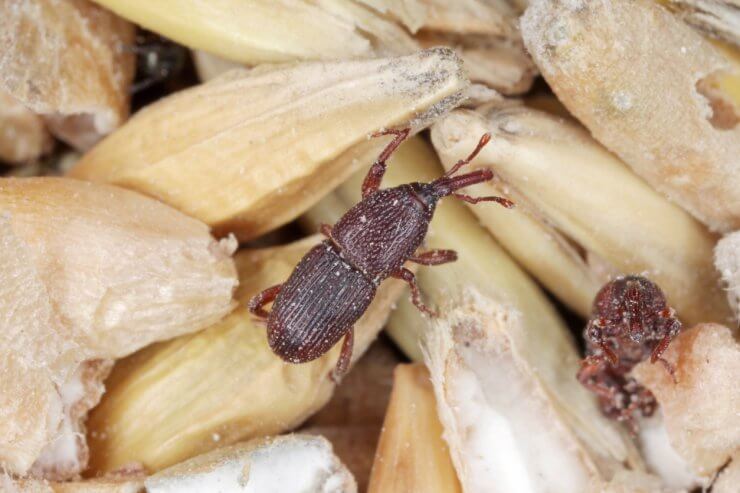
Wheat weevil on damaged grain
Pests in your wheat field, left unchecked, can damage and destroy your precious wheat plants—or even rob you of seeds before they get a chance to sprout.
The easiest to spot are birds, which will surely try to dine on your seeds the day you plant them. Small rodents like squirrels and chipmunks will also come thieving if they can get to your wheat seeds. You can deter animals from eating your wheat seed by pushing the seeds under the soil and tamping it down, putting a layer of straw over the newly planted seeds, or building a temporary hoop house over your wheat plot.
As for insects, there are several to watch for. Slugs and snails can decimate a newly planted patch of wheat, so use slug baits or treat the soil with diatomaceous earth to repel them. Once the plants are several inches high, slugs are no longer a serious threat.
Sawfly larvae can chew through the wheat stems and kill the plant if they completely circle the stem. The adults look like small wasps and can be controlled with insecticide in late spring.
Keeping a close watch on your plants during regular daily inspections will help you spot any pests before they can do irreparable harm.
How to deal with pests on wheat plants
Here are some proven ways to get rid of pests on your wheat plants. Choose the best treatment for the type of pests invading your plants.
- Inspect plants regularly. Look for signs of feeding and for eggs on the undersides of plants.
- Set out traps. Set out traps and baits for slugs if damage is detected.
- Pick off the pests. Use your garden gloves to remove the pests by hand. After removal, destroy pests by drowning them in a bucket of soapy water or crushing them with your foot. Handpicking isn’t efficient or practical for very small pests but works well with larger pests.
- Apply insecticidal soap. Insecticidal soap is organic. The potassium salts in insecticidal soap help remove an insect’s protective waxes, causing destruction of insect membranes and killing them. Insecticidal soaps are particularly effective on smaller pests. Mix the soap with water to create your solution and apply directly to insects on any plants. While insecticidal soap is less apt to affect other organisms, certain plants might be sensitive to the soap and can suffer leaf burn.
- Apply horticultural oils. Combine plant- or petroleum-based oils with water to produce horticultural sprays. Neem oil, for instance, is derived from seed extracts of the neem plant. Oil-based sprays block an insect’s air holes, interfere with an insect’s metabolism, disrupt insect feeding, and inhibit insect growth. Like insecticidal soaps, horticultural oils can cause plant injury if not properly diluted.
- Apply diatomaceous earth (DE). This substance on the ground around your plants will deter slugs, which don’t like to crawl over the DE.
- Make your own pest spray. You can make your own pest spray with benign materials. Mix one tablespoon of baking soda, 1/2 teaspoon of a mild dish detergent, and 2 1/2 tablespoons of olive oil in a gallon of water to make a solution that will repel all kinds of bugs. Shake it well in your bottle before spraying and repeat every week for it to be continuously effective.
Do pests attack your wheat plants every year? How do you handle removing them—and even preventing them in the first place?


 Previous
Previous

